Six Acoustic ‘York’ Phono Pre-amp – A Smooth Operator
‘In the House’ Review by David Neice
MSRP: $499 (CAD)
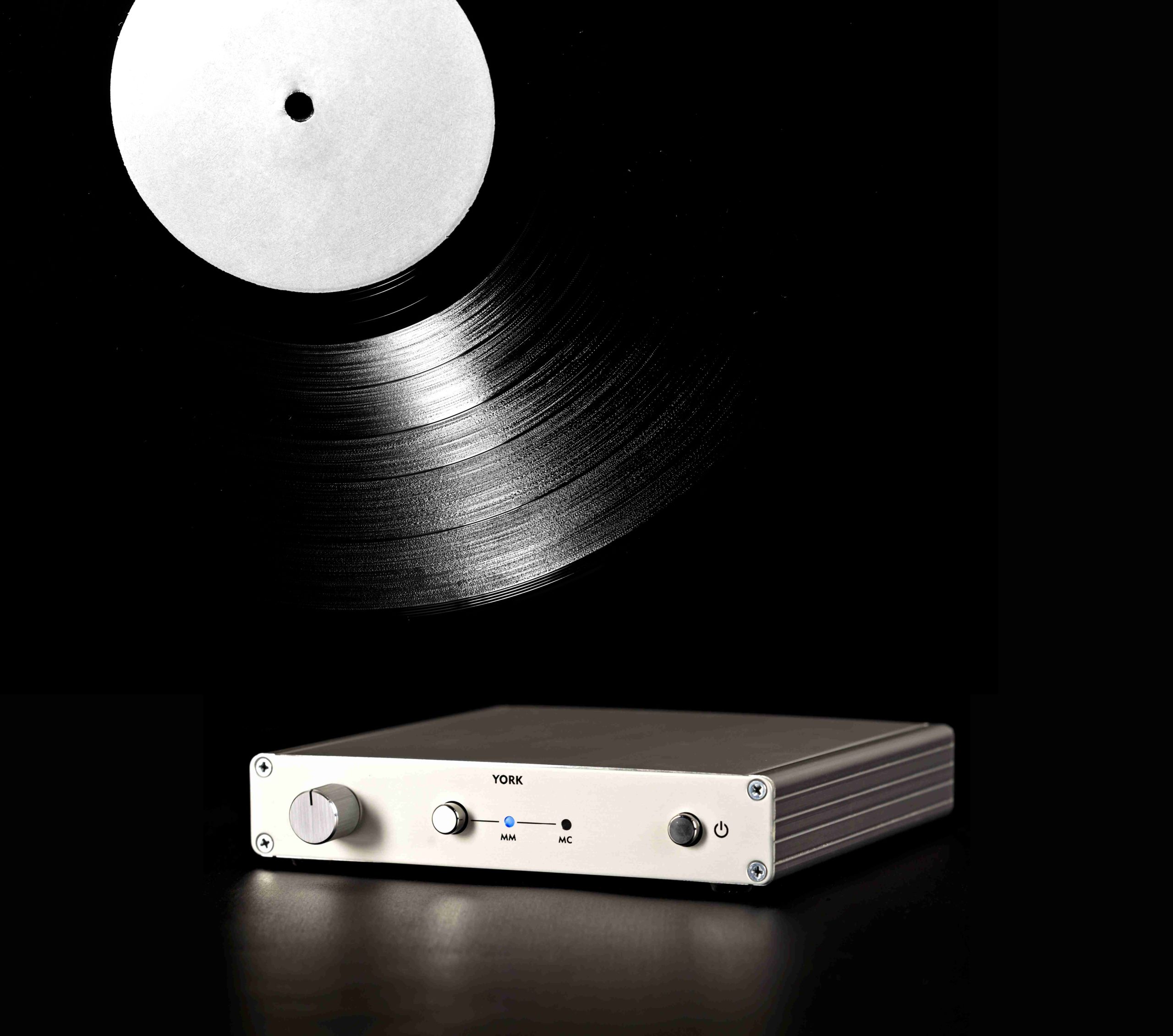
Verdict: A small Canadian audiophile company called ‘Six Acoustic’ offers a new and lovely little phono pre-amp (the York) at a decent suggested price. After my review period, I would characterize the sound field it throws as ‘velvet smooth’ and certainly worthy of serious consideration by the audiophile community. This phono preamp is almost a custom product as they are made in small quantities and the build quality is to the highest standard. The York phono pre is highly flexible regarding resistive and capacitive loading, and can therefore accommodate the complete range of both moving magnet (MM) and moving coil (MC) cartridges. If you are looking for a high quality phono preamp from a Canadian company, I would recommend you take it for a spin.
Yet Another Phono Pre?
Outside of the hi-end audio community nobody even thinks about a phono pre-amp as a useful consumer device. Even with the resurgence of vinyl the average user is mostly unaware of the virtues of having a separate phono stage. Low end turntables generally offer some limited RIAA equalization on board as do many home theatre receivers and so on and lots of integrated amplifiers have a phono stage built into them that is considered ‘good enough’ for and by the vast majority of users. In addition for about $100 one can purchase a decent phono stage at any Long and McQuade store.
Only the audiophile community, and in particular those wedded to separate components, thinks that spending several hundred dollars on a stand alone phono stage is a sound investment. So why would Six Acoustic offer this device as a signature product?
I asked that very question of the good folks at Six Acoustic and here is the reply offered by Steve Meszlenyi on behalf of the company. “There is a delicacy and fragility of the signals that emerge from vinyl that is perhaps not as pronounced in any other aspect of audio. It proves quite challenging to faithfully preserve the integrity of these tiny signals from the phono cartridge without introducing something, without colouring the output, and to remain true to the artists’ intentions. I think that the audiophile is sensitive to this. To meet the high end standard, I believe that a phono preamp must demonstrate an uncanny attention to detail present typically only in precision instrumentation for scientific purposes. This raises phono preamplification to a different category of amplification requiring component tolerances, layout geometries, and housing considerations that go well beyond those met by or even necessary in other audio amplification products.
As a result, the high-end phono preamp lends itself well to handcrafted precision component selection, and the avoidance of mass production. As a small company, this suits us well. Our hope with this product is that it creates an awareness among audiophiles of what Six Acoustic can do and to create a welcoming audience for our upcoming products.”
A Closer Look at a Phono Stage and RIAA Equalization
Let’s follow up on Steve’s argument and take a closer look at what exactly a phono stage does and therefore offers to an audiophile’s system. The really remarkable thing about a vinyl playback system is not that it works so spectacularly well, but rather that it works at all. A phono cartridge is a transducer and it converts the physical movement of the stylus into tiny electrical impulses. In other words it ‘transduces’ mechanical energy into electrical energy. A stylus is basically a V-shaped rock that gets dragged within a V-shaped groove on the surface of the vinyl. It is something like a big old rock being dragged in a ditch.
The relevant analogue information is stored in the two channels of stereo that form up the sides of the groove. So the stylus/rock has to follow complex modulations in the wavy and undulating surface of these two sides of the groove (simultaneously) as it ‘tracks’ the album’s surface. To visualize this, here are a couple of magnifications scraped from the web.
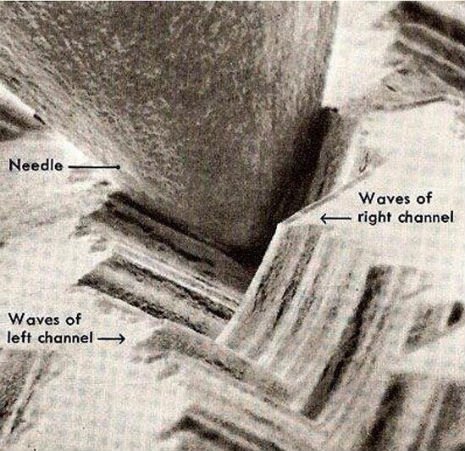
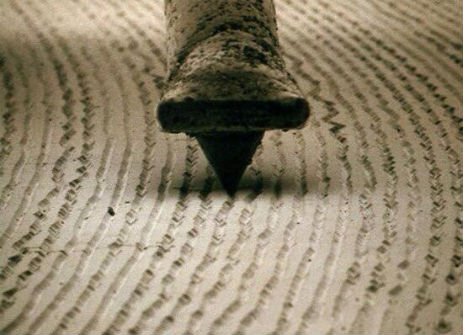
The movements of the stylus are in turn mirrored within the body of the cartridge where magnetic poles and fields convert these movements into tiny tiny millivolts of electrical energy. These electrical impulses stream down the phono cable and into the available phono stage, whether it is a stand alone like the York under review here, or a phono stage integrated into an amplifier or receiver. It is truly something of a wonder that it works at all.
The main role of a good phono stage is to effectively capture these tiny electrical impulses and not render any damage to their integrity. But there is a further internal step that is critical. The phono stage must adequately reverse the effects of RIAA equalization. RIAA equalization was established by the Record Industry Association of America as a specification for the recording and playback of (long playing) phonograph records. Essentially it is an international standard that allows more information to be placed in the grooves of a record, by effectively reducing the ‘ditch’ width required for preserving bass information.
Quoting from Wikipedia: “RIAA equalization is a form of pre-emphasis on recording and de-emphasis on playback. A recording is made with the low frequencies reduced and the high frequencies boosted, and on playback, the opposite occurs. The net result is a flat frequency response, but with attenuation of high-frequency noise such as hiss and clicks that arise from the recording medium. Reducing the low frequencies also limits the excursions the cutter needs to make when cutting a groove. Groove width is thus reduced, allowing more grooves to fit into a given surface area, permitting longer recording times. This also reduces physical stresses on the stylus, which might otherwise cause distortion or groove damage during playback.”
Further details on RIAA equalization can be found here.
https://en.wikipedia.org/wiki/RIAA_equalization
Achieving the correct result, ‘a flat frequency response’, is an exceedingly difficult thing to do, and the phono stage is charged with its full responsibility in the play-back chain. Careful engineering is required and this has to be tested against real world listening experiments. In addition, the internal components chosen for a phono stage, the resistors and capacitors and so on, all can add subtle sonic flavours to the final outcome in the tone and sound stage, and so careful listening is required as well as careful selection and matching of internal parts. This is referred to in the industry as ‘voicing’ a component. The engineering required to produce a high quality phono stage is a labour of love.
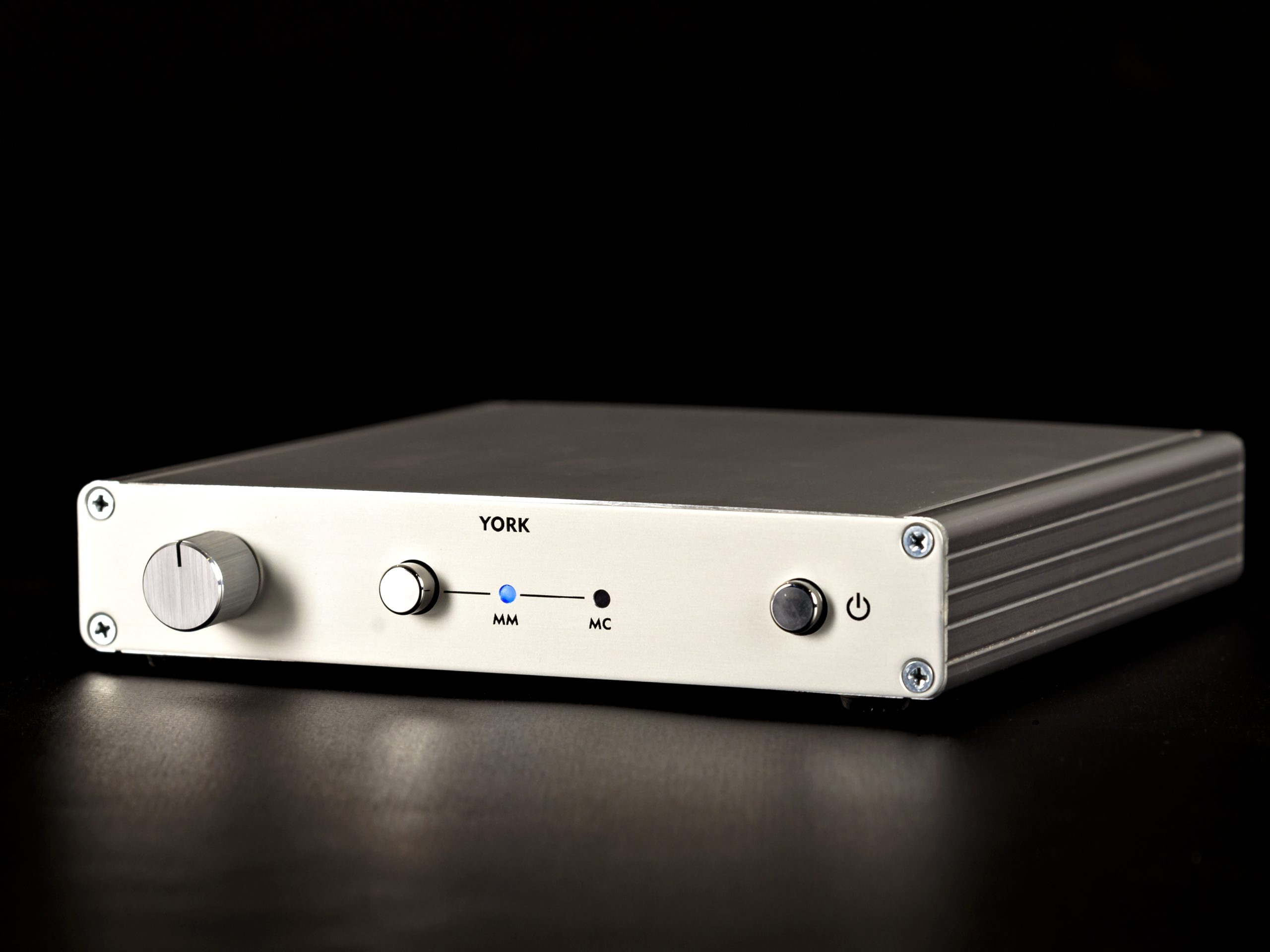
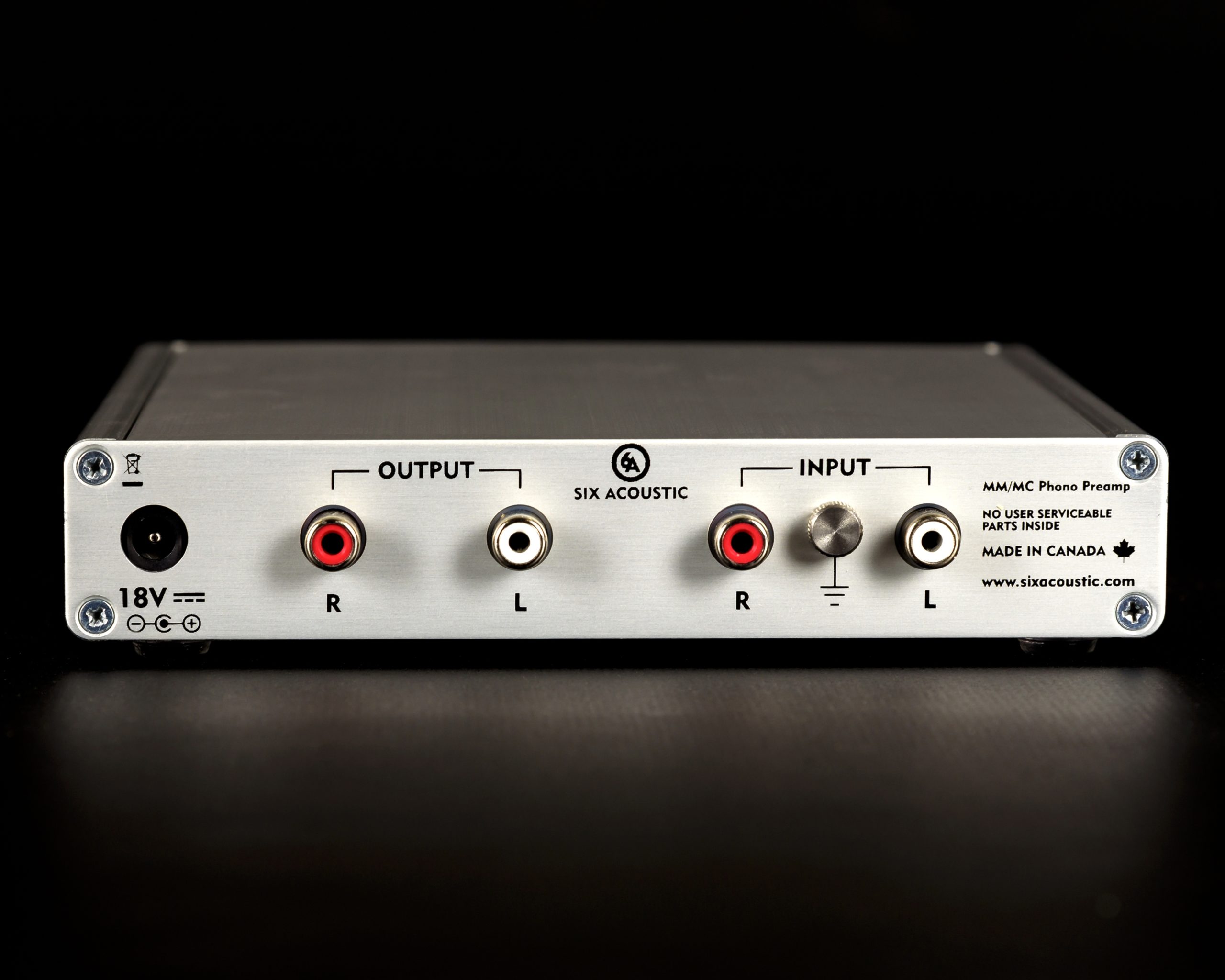
Build Quality
The York phono stage and its power supply is nicely packaged, and the build quality is very good. It is housed in a slim aluminum enclosure with a blue LED light on the front that is just the right intensity. There is a front mounted on/off switch and a button that controls the choice of a MM or MC cartridge. Very unusually, there is also a gain control. With this knob you can set the level of gain infinitely for both the MM and MC input. This allows very close gain matching so there are no surprises when you switch in and out of the phono input on your amplifier. The middle detent position on the knob offers a good starting point.
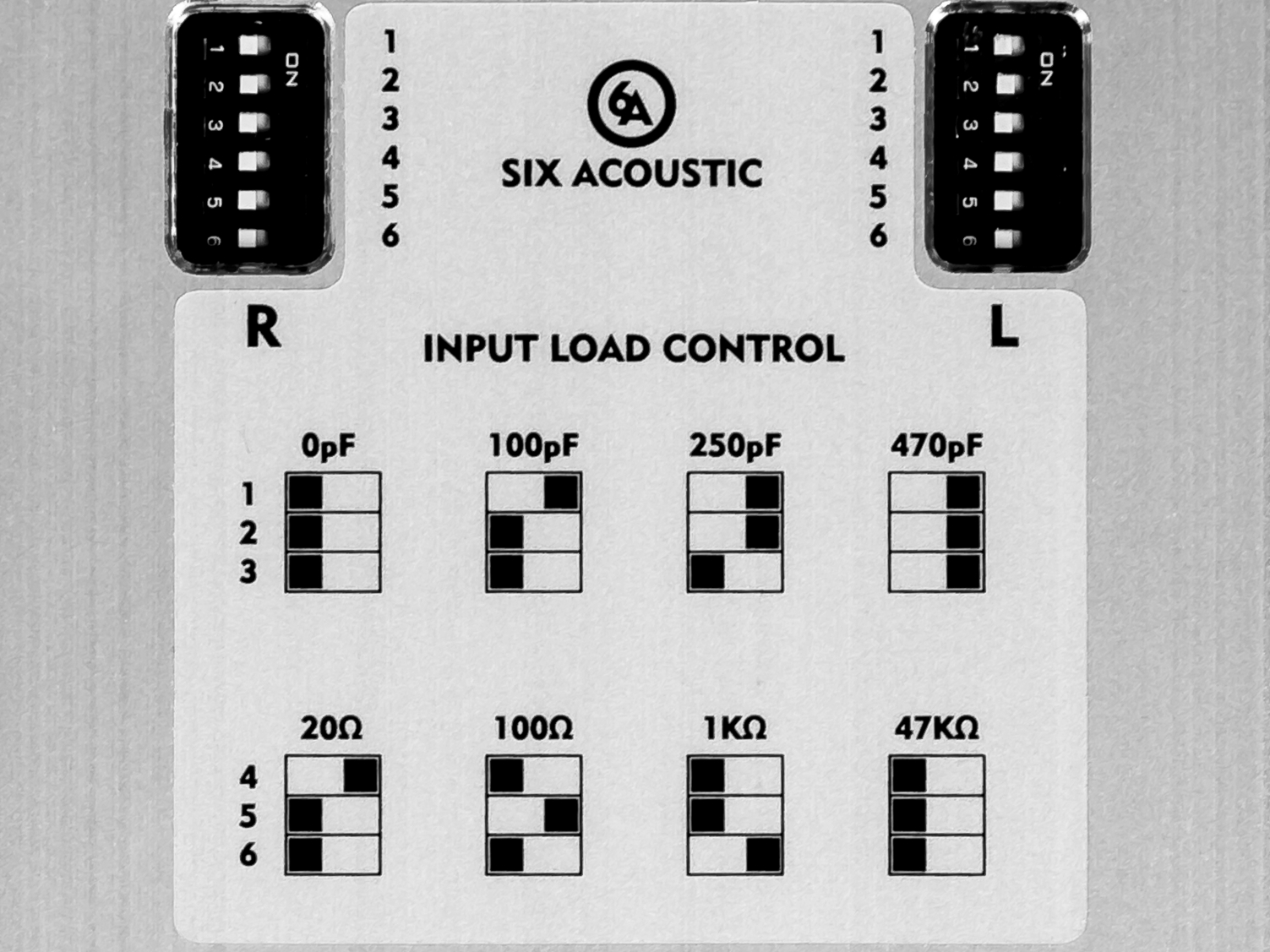 The back of the pre-amp contains the RCA inputs and outputs as well as a substantial tone arm ground post. The bottom of the chassis has a series of DIP switches that allow custom tailoring of the resistance and capacitance levels that will match your cartridge, I am using a HANA EL (a low output moving coil) and the York came to me pre-configured to match my cartridge. However, the package supplied by Six Acoustic includes a solid plastic ‘pen’ that the user can employ to adjust the DIP switches as required. Some attention to detail is needed to set these switches as this can be confusing when first approached, but their operation is simple enough and no harm is done if you achieve the wrong settings initially. Users will just need to double check their switch work and ensure they have the data that they need on their respective cartridge.
The back of the pre-amp contains the RCA inputs and outputs as well as a substantial tone arm ground post. The bottom of the chassis has a series of DIP switches that allow custom tailoring of the resistance and capacitance levels that will match your cartridge, I am using a HANA EL (a low output moving coil) and the York came to me pre-configured to match my cartridge. However, the package supplied by Six Acoustic includes a solid plastic ‘pen’ that the user can employ to adjust the DIP switches as required. Some attention to detail is needed to set these switches as this can be confusing when first approached, but their operation is simple enough and no harm is done if you achieve the wrong settings initially. Users will just need to double check their switch work and ensure they have the data that they need on their respective cartridge.
Overall I would give the York a big thumbs up for the execution of its design and build quality. This is a sleek unit with enormous flexibility and is worthy of any audiophile system.
Listening to the York Phono Stage
I jacked the York into a spare line level input on my Unison Research ‘Simply Italy’ SET amplifier. The HANA cartridge is mounted on a Gold Note Valore Special Edition turntable and uses a custom phono cable made by Audio Sensibility that is made with OCC (Ohno Continuous Cast) copper to carry the signal to the phono stage. My RCA audio interconnects are DIY using Kimber PBJ. Vinyl is a retro format so I chose to listen to a series of classic albums where I was sure the quality of my samples were as close to pristine as my collection can offer. In some cases I do have close to mint copies of certain albums from the seventies and eighties that can really test a system. I began by listening to three test discs over a series of evenings.
Willie Nelson
A highlight of 1980s vinyl is the classic Willie Nelson album ‘Stardust’. How does he do it? He takes these old chestnuts from the American songbook like ‘Moonlight in Vermont’, and with a little twist here and there he makes them his own. It is remarkable.
Through the York phono stage the rich vibrato of Willie’s voice (and his ancient guitar) comes through loud and clear. In particular the track ‘Georgia’, which may be about a US state or may be about a girl, was dripping with emotion. Also the selection ‘Unchained Melody’ was rendered with a magic touch that had me stopped dead in my tracks. Willie was ‘right there’, knocking at the door to my heart and bringing all that country and western grit to the music. It was delightful and I returned to this album several times during the review period.
Bob James
I have an almost pristine copy of the classic Bob James album ‘Heads’. This record was a collaboration between James and Grover Washington Jr., and contains several tracks that I routinely use to test a system or its components. In particular it has a version of ‘You Are So Beautiful’ that highlights Washington on soprano saxophone. The soprano sax is one of my all-time favourite instruments, and is very hard to get tonally right. The great master of this jazz instrument was John Coltrane, but Washington proves to be a force to reckon with on this album.
Mastery of the soprano sax can take decades to achieve. Washington has a subtle slow vibrato that is only revealed on the most penetrating of play back systems. With the York phono stage in place, I found the reproduction of the tonal properties of the soprano sax to be exemplary, and Washington’s slow vibrato was reproduced cleanly and with a light and airy touch. I ached to reach the end of this track, and it made me wish I had a CD version so I could play it several times back to back, a pleasure that only CDs can offer us.
Stevie Winwood
Yet another pristine album in my vinyl collection is the 1982 recording by Stevie Winwood of ‘Talking Back to the Night’. I am a big Winwood fan and have most of his catalogue, going all the way back to The Spencer Davis Group. Winwood’s voice is a particular challenge for any audio system. His diction is not always clear and the sound emitted can be rendered muffled if the system cannot resolve his words. I often use his albums as a test of the ‘midrange clarity’ of a system. It is quite a harsh test as this difficulty with his voice spans the whole catalogue of his recordings. A component must be quite adept at midrange precision to pass the test offered by his voice.
Three of my favourite tracks on this album are ‘Valerie’, ‘Help Me Angel’ as well as ‘And I Go’. I played these tracks several times during the review period, along with the rest of the album. I found the York phono preamp to be well up to this test, even if it was not quite as resolving as my reference preamp (see footnote 1).
There was a good sense of rhythmic drive which propels these tracks forward, and the clarity in Winwood’s voice allowed me to ignore the liner notes. The soundstage was large and filled with expressive instrumental vigour, a classic characteristic of the best of the Winwood tracks. Stevie’s signature use of an expressive synthesizer ‘voice’ that permeates his keyboard playing was rendered in all its electro-mechanical glory. On balance, I was thrilled at the way this album was reproduced and it largely cemented my overall impression of the York phono preamp.
Listening Summary
Of course there was a large parade of other albums that I listened to during the review period, but rather than discuss them ad nauseum, I have selected the above three as examples of the capabilities of the York phono stage. The York presents a very smooth and listenable sound field even if it perhaps does not offer the last smidgeon of resolution. Practically speaking, to get that last smidgeon one may have to spend several thousands of dollars on a phono stage. Within the limits of its rather modest cost, the York does a fine job of reproducing the essence of all the albums I auditioned.
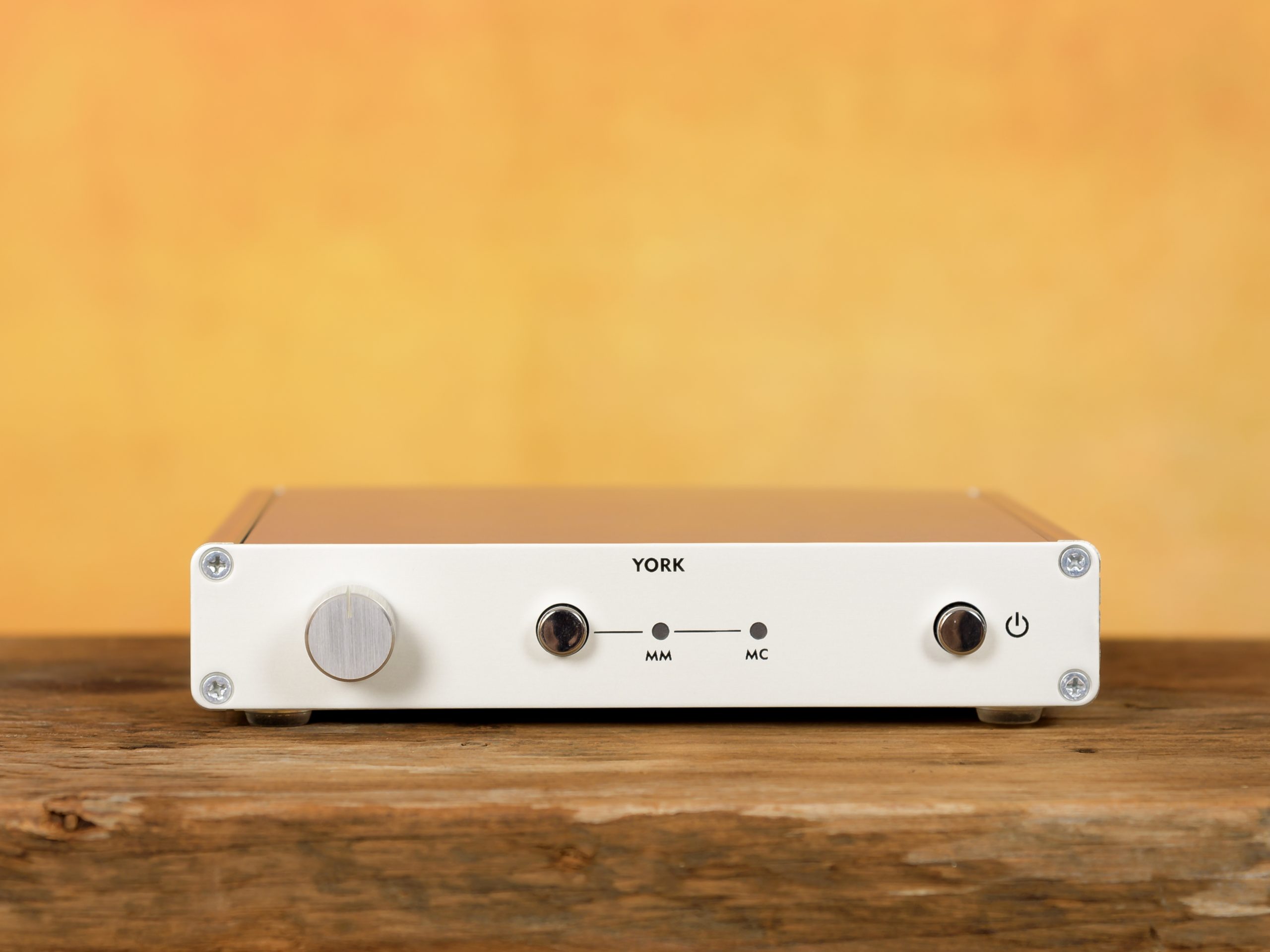
Further Thoughts
I asked the people at Six Acoustic to give me a sense of how they had settled on a price point for the design of their York phono pre-amp and here is their reply.
“I think one will find that there are phono stages ranging in price from $20 to $20,000 and above. However, the most startling differences seem to be in the jump from <$100 to >$500 phono stages wherein even a casual listener will notice a dramatic improvement in terms of performance. We wanted to target the vinyl enthusiast who was looking for that goose bump inducing elevation of their listening experience. One unexpected outcome has been the heartfelt positive feedback arriving directly from users of the York which has served to not only validate our design intentions but has set a standard for us to meet in our future developments. It’s also a nice feeling to know that you’ve made someone very happy in some small way and this is reinforced by emails and phone calls from new users nearly daily.”
Conclusion
The York phono pre-amp is a choice piece of quality audio gear made right here in central Canada. The sound field it offers is smooth and refined, and build quality is to the highest order. The flexibility available to the user when it comes to signal gain and cartridge loading is as extensive as it gets. All things considered, I would recommend that if you are in the market for a mid-priced phono stage, that you give the York a whirl.
Six Acoustic York Phono Preamp
MSRP $499 Canadian
Product Page: https://www.sixacoustic.com/yorkoverview
Footnote 1: I routinely use a Musical Fidelity ‘The Preamp II’ as my go to phono stage. This is an older design and is a full preamp rather than just a phono stage, but I like its flexibility and sound field.
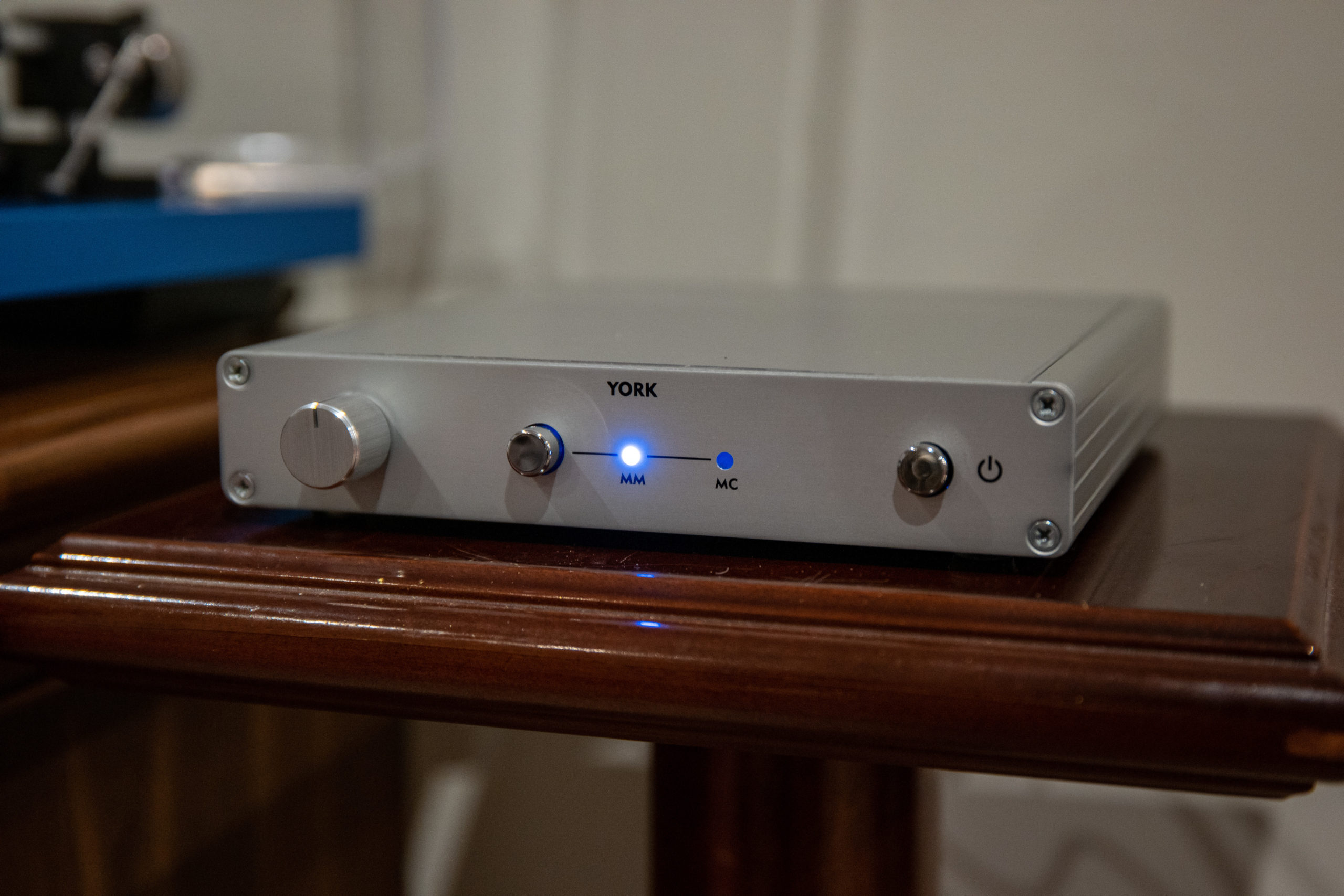

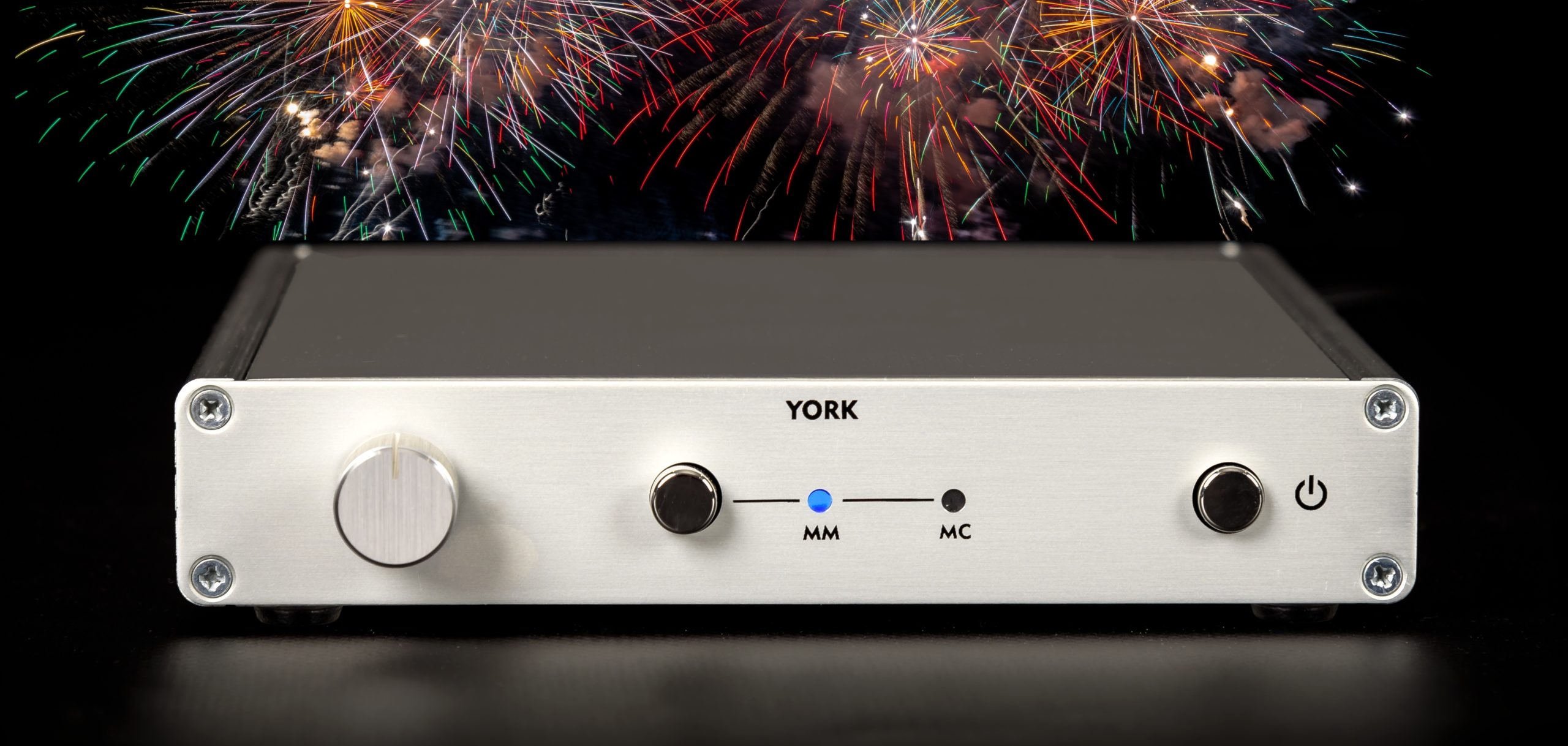



I have owned anotherr phono pre amp and me and my friend bought the York amp we have talked about it and we agree it is very detailed and clear we cannot believe what we have in hand for that price i am sure that we put this phono amp against more expensiv phono amp and it is right up there with them
Please let us know which model you compared it to?
You might want to correct the spelling of the company name. It is singular acoustic.
Thanks! Changes made.